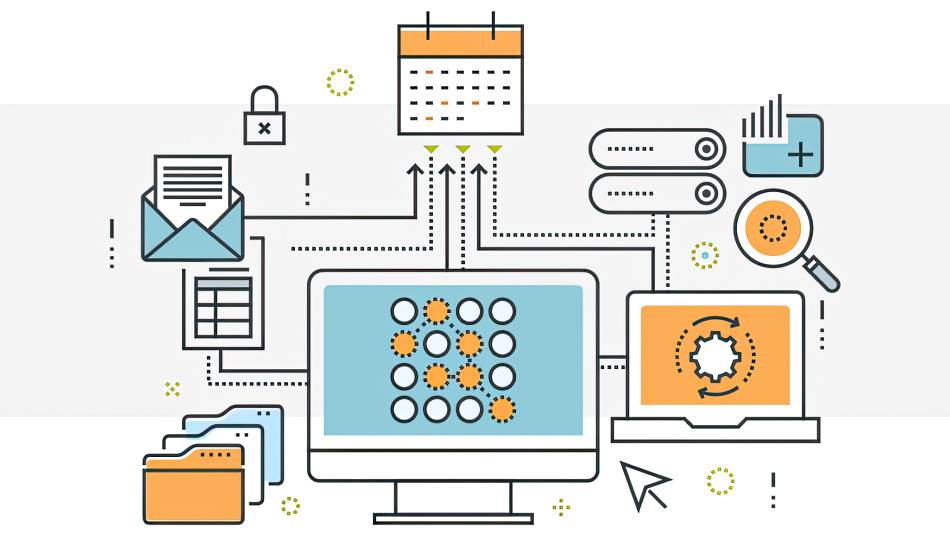How many hours of your life (or your team members’ lives) have been lost to creating and maintaining spreadsheets? Whether you’re tracking employee activity or editing swaths of data, these tedious manual tasks are stealing precious time your department could — and should — be allocating to high-value work.

Like most managers, you’re already being asked to do more with less. So, here’s your permission to lighten your load and automate your time-consuming processes with secure, web-based tools.
From compliance documentation to employee volunteer programs — the processes you can automate with a custom web application are nearly limitless. As is the time you stand to save. Consider the top three benefits of automating your internal comms or HR tasks. Because we know you won’t miss the conditional formatting, endless hidden tabs or broken formulas that come with spreadsheet management.
1. Eliminate human error for more trustworthy data
Manual processes are too often inaccurate and unreliable. Plain and simple. That’s because humans are prone to mistakes. If you’re relying on your employees (even the best ones) to manually enter information, errors are unavoidable. And the more people that have a hand in any given spreadsheet or manual task, the more likely you are to end up with erroneous data. In fact, it’s estimated that approximately 88% of manual spreadsheets contain errors.
If you can’t rely on the accuracy (or timeliness) of your information, how useful is that information to you anyway? You need a single source of truth that’s free from human error.
Automating your processes gives you that better source of truth. An easy-to-use web-based app provides the consistent information you require — and the confidence that the results are accurate and, therefore, actionable. Not to mention, with an automated system you’ll get trackable output more quickly than you ever could with people processing the same data.
How Macy's automated employee engagement tracking
Consider an actual client scenario. Macy’s had a data accuracy issue with their legacy, Excel-based system of tracking employee engagement contests. The system relied on emailed requests, which were manually managed in an unwieldy spreadsheet. The spreadsheet changed hands too many times, rendering the data error-prone and, consequently, unreliable.
We implemented a cross-functional, automated system throughout Macy’s entire network of stores. And as a clear testament to the power of automating manual processes, Macy’s engaged our team to build a similar system for its sister brand Bloomingdale’s.
2. Increase your team’s productivity and preserve their sanity with process automation
Having humans run manual processes isn’t only problematic because it tends to result in data inaccuracy. It’s also detrimental to productivity.
Your employees can’t possibly reach peak productivity if they’re spending their time completing manual tasks like data entry. Not to mention, their morale will surely suffer the longer they live inside mind-numbing spreadsheets. And we don’t need to tell you what unengaged, unhappy employees mean for your retention rate.
Simply put, automating these tedious processes reduces the time your people need to complete their work. It also lowers the number of people needed on each task because, thanks to automation, the tasks are quicker to complete. In both cases, employees can shift their focus to high-value to-dos that make better use of their time and talents. In turn, they’ll feel more satisfied in their roles.
More process automation for Macy's
The retailer returned to us to develop multiple custom apps because of the success of each previous initiative. In this case, they asked us to architect a benefits portal that would present each employee with their specific benefits package.
Not only did this new system cut costs and decrease human error, it also increased employee satisfaction. Further, it ensured employees could easily access the healthcare information they needed.
3. Garner actionable insights for compliance purposes and beyond
We’ve already hinted at the fact that automated process grant instant access to actionable insights that wouldn’t normally be so readily available. For instance, automated systems produce data reports as a matter of course. No more manual aggregating and analyzing. You can use these reports to make more informed business decisions. These decisions are also more objective because they’re based on quality data, not manually entered, mistake-prone info.
Speaking of objectivity, if there’s a compliance framework your company must follow, you really need the unbiased data that comes from automating your processes.
Many of our clients are required to follow the Sarbanes-Oxley Act, which protects employees of public companies from being fired for specific reasons. In one instance, we created a custom digital platform that allowed our client to track the explanations behind layoffs. As a result, they are able to comply with the legislation, provide proof that they’ve done so and avoid any penalties.
Finally, your data is more secure and private in a protected, web-based tool simply because it’s exposed to fewer eyes manually manipulating it. Data security is of the utmost importance to your employees and your company overall — especially if it’s required for compliance reporting.
Say goodbye to spreadsheets and hello to modern processes
Hopefully the advantages of automating your manual processes are abundantly clear. It’s also critical to note that there are so many tasks that can be automated. Nearly any process involving data, spreadsheets, dashboards, reporting, applicants or benefits information can be ushered into the present day with automation.
What kind of proprietary, automated solution can we build for you? We’d love to help make your team more productive and your data more secure and actionable.